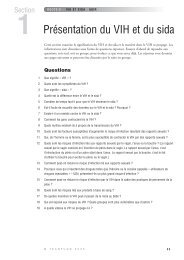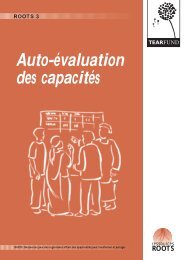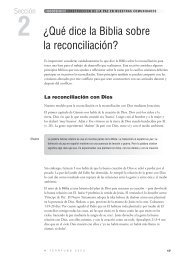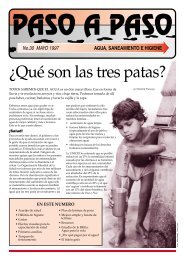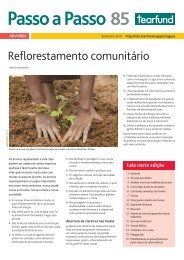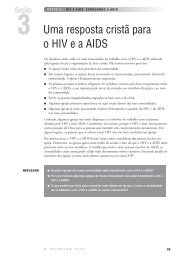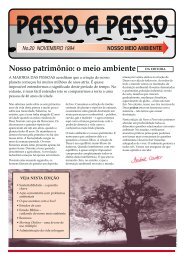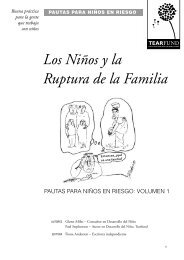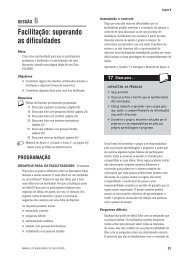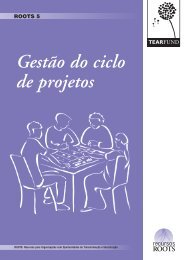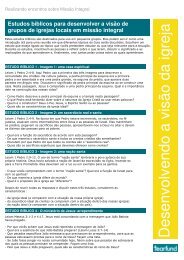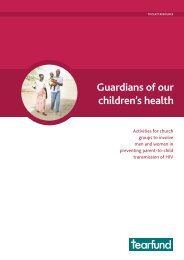Children and Family Breakdown - The Tearfund International ...
Children and Family Breakdown - The Tearfund International ...
Children and Family Breakdown - The Tearfund International ...
You also want an ePaper? Increase the reach of your titles
YUMPU automatically turns print PDFs into web optimized ePapers that Google loves.
CHILDREN AT RISK GUIDELINES<br />
6.5 <strong>The</strong> cultural <strong>and</strong> religious context of the child, family <strong>and</strong> community is taken into<br />
consideration.<br />
PRINCIPLE 7 ADVOCACY<br />
■ This includes caste, ethnicity <strong>and</strong> religious belief. Some cultural beliefs may be<br />
harmful, even evil (eg female genital mutilation) <strong>and</strong> in such cases Christians will<br />
need to challenge them. At the same time other cultural beliefs (eg resting after the<br />
birth of a baby) will be helpful <strong>and</strong> should be encouraged. Discernment is needed<br />
with beliefs that are not so clear cut.<br />
■ Underst<strong>and</strong>ing of what family means will vary. This is not just a cross cultural<br />
matter – politicians, economists, theologians, feminists all have their own agendas.<br />
It is important to underst<strong>and</strong> who is speaking, for whom, <strong>and</strong> why. 21<br />
■ Underst<strong>and</strong>ing a culture’s views on marriage <strong>and</strong> fertility is important. For<br />
example in some cultures, marriage is conducted at an early age but the children are<br />
kept apart until later. In others it is not seen to be fully consummated until a child<br />
is born. This can further exacerbate the stress <strong>and</strong> disappointment of infertility.<br />
■ Child rearing practices will vary considerably even within one community but on<br />
close observation there may be patterns that emerge.<br />
■ <strong>The</strong> nature <strong>and</strong> level of domestic violence needs to be assessed <strong>and</strong> appropriate<br />
strategies determined for who should challenge it <strong>and</strong> how.<br />
7.1 Lobbying <strong>and</strong> interceding with or on behalf of children <strong>and</strong> their<br />
families takes place at local, national or international levels.<br />
■ Organisations should identify key issues that affect families<br />
negatively, <strong>and</strong> develop advocacy strategies to influence the<br />
decision-makers. <strong>The</strong>se can be at a local or national level.<br />
7.2 <strong>The</strong> programme staff are aware of the importance of the UN Convention on the Rights of<br />
the Child <strong>and</strong> other human rights issues <strong>and</strong> conventions.<br />
■ This is a controversial area <strong>and</strong> needs careful consideration. <strong>Tearfund</strong> believes that<br />
the UN Convention must be interpreted in such a way that the guidance <strong>and</strong><br />
responsibilities of parents are given priority. <strong>Children</strong> are entitled to choice, but<br />
choice carries with it responsibilities <strong>and</strong> full participation is something into which<br />
children grow. Whilst still young they need guidance, preferably from parents but<br />
otherwise a responsible guardian to support them in making decisions. As they get<br />
older they will need to be given more opportunity to make their own choices.<br />
21 Barton, S (1993).<br />
VOLUME 1: CHILDREN AND FAMILY BREAKDOWN<br />
27



